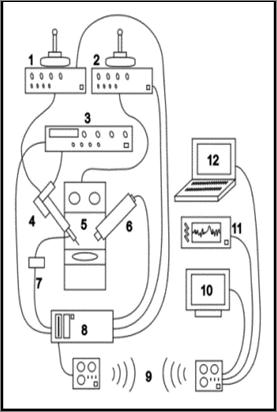gravitational impact on ion channels incorporated into planar lipid bilayers (PATCH-CLAMP / streulicht)

research area: biology
experiment title:
Der Einfluss verschiedener Gravitationsbedingungen auf das Verhalten künstlicher und nativer Ionenkanäle
experiment acronym: PATCH-CLAMP / Streulicht
funding agency: DLR
grant number: 50WB9716
performing organization:
Institut für Physiologie, Abt. Membranphysiologie, Universität Hohenheim, Stuttgart
prime investigator: Prof. Dr. Wolfgang Hanke
experiment objective
abstract
Until now, not much is known about whether and how single (neuronal) cells and (neuronal) tissues sense gravity and which mechanisms they use to react to changes in gravity. The aim of the study was to investigate the effects of micro and hyper gravity on the activity of artificial and native ion channels as well in artificial lipid membranes as in living cells. The activity of ion channels is the functional basis of signal processing in the brain. Mainly electrophysiological methods, such as bilayer and patch-clamp techniques were used. Additionally, the reaction of self organised waves in excitable media (brain tissue) to gravity was investigated. Therefore we used the well established model of the retinal spreading depression with mainly optical methods and video imaging techniques. The phenomenon of spreading depression, again, is mainly based on the action of ion channels and other ion transport mechanisms of the neuronal and glia cells of the tissue involved. The electrophysiological experiments showed that artificial as well as native ion channels incorporated into lipid membranes do react to changes in gravity. Mainly the channel kinetics are effected, giving an increasing open state probability with increasing gravity and decreasing open state probability with micro gravity. These results can also be transferred to complex systems: the spreading velocity of spreading depression decreases in micro gravity and increases with increasing gravity, this might be explained mainly by altered ion channel activity. In addition it was found that the onset of the wave after the stimulus was delayed by 40 - 50% under micro gravity conditions, indicating a lower excitability of the neuronal tissue. The results clearly show that the ion channels activity in artificial lipid membranes as well as in complex neuronal tissue interact very sensitive with gravity. Until now the experiments with single neuronal cells did not show clear effects. But also here a gravity dependence of ion channel activity can be expected, which has to be verified in further
related publications
- Klinke, N., Goldermann, M. and Hanke, W.: The properties of alamethicin incorporated into planar lipid bilayers under the influence of microgravity. Acta Astronautica, 47, 771-773 (2000)
- Goldermann, M. and Hanke, W.: Ion channels are sensitive to gravity changes. J. Microgravity Sci. Technol., XIII/1, 35-38 (2001)
- Meissner, K. and Hanke W., Patch-Clamp experiments under micro gravity, J. Gravit. Physiol. 9, P377-8 (2002)
experimental setup

experiment campaigns
experiment year: 2004
Number of drops: 15 (Streulicht)
experiment year: 2003
number of drops: 17 (PATCH-CLAMP)
experiment year: 2002
number of drops: 19 (PATCH-CLAMP)
experiment year: 2001
number of drops: 16 (PATCH-CLAMP)
experiment year: 2000
number of drops: 16 (PATCH-CLAMP)


 "
"